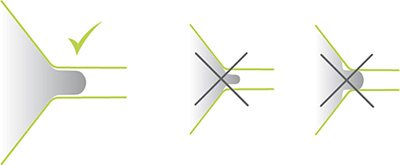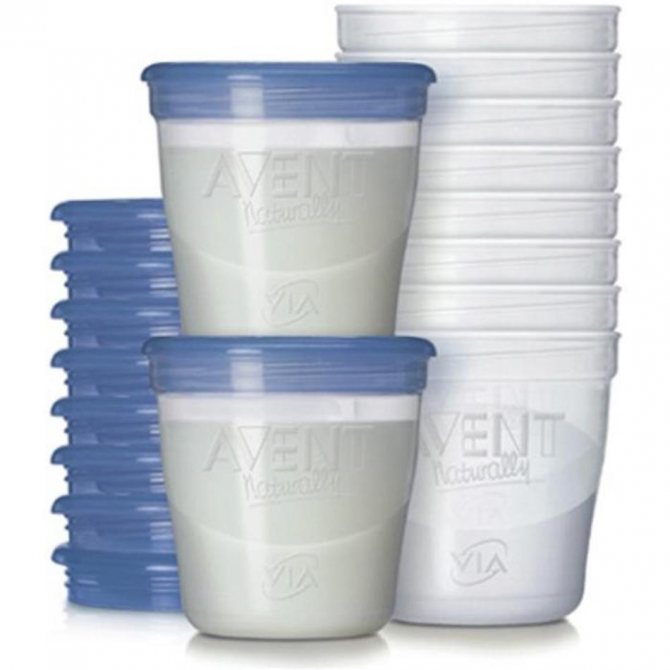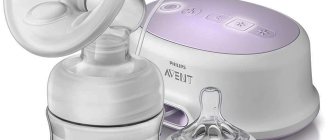There is an opinion that in order for milk to come in faster and not stagnate, you need to express your breasts. Is it necessary to express colostrum and how to do it correctly? We'll talk about this in today's article.
The release of colostrum in pregnant women is a normal natural process. Although its absence is also not a deviation from the norm. In some pregnant women, it begins to secrete in the first trimester of pregnancy. Others notice the arrival of colostrum only after childbirth. It should be noted that there is no direct relationship between the amount of colostrum during pregnancy and the amount of breast milk during breastfeeding. The abundant secretion of colostrum during pregnancy does not at all guarantee a woman the absence of problems during breastfeeding.
When should you express milk?
- Birth of a premature baby. Babies born prematurely may not have a developed sucking reflex, and their need to receive mother's milk is perhaps even higher than that of full-term babies. After all, he must quickly gain strength and make up for everything that he did not have time to do, being born earlier.
- Poorly developed sucking reflex. Such children fall asleep during feeding, swallow rarely, are lethargic, and in some cases may refuse to breastfeed.
- Insufficient lactation. It can be observed both from the first days and appear after some time.
- Establishment of lactation. Immediately after childbirth, the mother begins to produce colostrum, which, despite its small volume, is nourishing and very healthy. After colostrum comes milk, the amount of which is usually too large for a newborn. At this stage, it is important that the overfilled breasts be emptied so that the already stronger baby will have enough milk in the future. There is no need to be fanatical here, expressing everything to the last drop; it is quite enough if you feel that the breasts have become soft and the feeling of fullness in the chest has gone away.
- Stagnation of milk (lactostasis), which threatens the development of mastitis. It can be caused by various reasons, including improper pumping. It is observed in individual lobules of the breast due to blockage of the ducts leading to the nipple. In this case, milk is expressed from separate lobules of the mammary gland that have hardened from excess milk.
- Taking medications that can be passed on to the baby through breast milk. Expressing in this case serves as a tool to maintain lactation in the future. Expressed milk has to be thrown away. At this time, the baby eats formula, unless the mother, knowing about the upcoming medication, has not prepared expressed milk in advance.
- Inverted or flat nipple. Before you start pumping for this reason, you should try using special breast pads and if nothing works out, start pumping.
- The child is separated from his mother. The need is quite understandable, because if the mother works, is forced to leave for several hours, or if the child is undergoing treatment without the mother, the child cannot be left without breast milk, especially since lactation may decrease with regular separation.
Reasons for expressing milk
The process of breastfeeding occurs on the principle of supply and demand. Many nursing mothers find themselves in a situation where they need to express breast milk:
- The process of harmonization is the creation and secretion of milk through the process of breastfeeding. In case of heavy and congested breasts, releasing a small amount of milk will relieve breast congestion and bring a feeling of relief. In this situation, the mother should express as much milk with her hands as necessary to reduce the tension in her.
- When a baby refuses breastfeeding due to illness, seizures, etc., expressed milk can be offered to him in a spoon or bottle .
- In situations where nursing mothers want to maintain lactation but are separated from the baby (for example, hospitalization).
- For blocked ducts and breast infection (mastitis).
- Increasing or maintaining adequate milk supply.
- Collecting milk for feeding while the mother is far from home .
- Cup or spoon feeding when the baby (premature or otherwise) is too weak to suck or uneven oral development prevents sucking.
- Preventing breast fullness and maintaining milk production if breastfeeding is temporarily interrupted due to illness (of the mother or child).
Which method to choose
There are two ways to express - expressing by hand and using a breast pump. The main guideline for choosing one method or another should be the frequency of pumping. If you do not plan to be separated from your baby for a long time, for example, when going to work, then you most likely will not need a breast pump. In this case, it is best to master the technique of hand expression.
Important! The main guideline for choosing one method or another should be the frequency of pumping. If you plan on expressing occasionally, then it is better to choose hand expression.
When not to pump
There are contraindications on the part of the child and on the part of the mother.
Contraindications for children
- lactose intolerance;
- leucinosis (“maple syrup disease”);
- phenylketonuria;
- developmental anomalies of the gastrointestinal tract.
Contraindications from the mother
Absolute (breastfeeding is strictly prohibited):
- HIV infection;
- AIDS;
- parenteral hepatitis.
Relative (breastfeeding is interrupted until the root cause is eliminated):
- severe illnesses that prevent you from caring for your child;
- herpesvirus disease;
- use of psychotropic drugs;
- treatment with radioactive drugs;
- the use of a large number of iodine-containing drugs;
- treatment of tumors using chemotherapy or radiotherapy.
You should be extremely careful when breastfeeding:
- the presence of inflammatory processes in the mammary gland;
- maternal illness for tuberculosis;
- maternal drug use.
In such cases, the decision on the need for breastfeeding is made by a medical commission.
Recommendations before pumping
Regardless of which pumping method you use, to increase its effectiveness, you need to remember some simple rules.
- if possible, sit next to the baby, let him touch the breast - this will release more milk;
- if the baby is not around, look at his photo, think about him;
- 10-15 minutes before pumping, drink a warm drink;
- take a warm shower or apply a towel soaked in warm water to your chest;
- Do a breast massage using one of the options suggested below.
1 massage option
Sit comfortably and do a light, pressure-free chest massage. To do this, first make circular movements with four fingers from the edge of the breast to the nipple (Fig. 1), and then stroking the mammary gland along the flow of milk (Fig. 2). Such movements will help the movement of milk even through the narrowest ducts. Areas with compactions are massaged with spiral stroking and finger tapping. At the next stage, it is necessary to form the nipple by first squeezing the isola (Fig. 3), and then, as if stretching the nipple itself with your fingertips (Fig. 4).
2 massage option
Place the mammary gland between two palms and, bringing your palms together, gently squeeze it. Next, use your fingers to smoothly move your breasts, first away from the armpit and then towards it. Return to the original position and grab your chest, squeezing lightly with both palms, as shown in the last picture.
As soon as the milk begins to flow out, you can start pumping.
Breast preparation
For optimal results, it is recommended to rely on the physiological basis of lactation. To achieve the best result, it is recommended to carry out a number of actions 15-20 minutes before pumping:
- apply a warm towel to your breasts or take a warm shower before pumping;
- drink a warm soft drink (coffee is not recommended);
- perform a smooth, light massage of the breast: starting from the upper part of the gland, move your fingers in a circular motion on a certain area of the breast, then perform the procedure on the next area. I move my fingers in a spiral from the upper area to the areola, after which the breasts are stroked from top to bottom;
- bend down or hang down your chest.
Performing these actions allows you to relax the nervous system and improve milk flow.
Attention! Expressing the free breast while feeding the baby with the other breast allows you to improve the passage of secretions.
Before expressing, the breasts must be thoroughly washed with soap and dried from water.
Manual method: instructions and video
- Prepare a clean container with a wide neck and a towel, and wash your hands.
- Place your thumb on top of your chest, and place the rest of your fingers under your chest. The distance from the fingers to the nipple should be approximately 2.5-4 cm, depending on the size of the breast.
- With a gentle movement, the chest is compressed with the fingers towards the chest, i.e. back, after which the fingers move forward to the nipple. The movements should not resemble friction, but rather rolling. Then repeat in the same sequence. At the beginning of lactation, these actions may take several minutes. The pressure should not be increased. We must patiently continue squeezing. At the same time, milk is released, first drop by drop, and then in streams.
- Move your fingers around the breast so that milk comes out from all the breasts. You will understand when to do this by the nature of milk secretion.
- Try not to let your fingers move onto the nipple when sliding towards it, otherwise injury may occur.
- To prevent your fingers from slipping due to droplets of milk, wipe your chest and arms from time to time.
Important! At the beginning of lactation, pumping can be unpleasant or even painful, but if you feel pain when pumping a healthy breast when lactation is already established, there is reason to think that something is going wrong.
How to express breasts by hand
Correct execution of the technique ensures optimal secretion passage and prevention of stagnation.
Pre-prepare a clean container for storing milk and wash your hands. Before each use, it is thoroughly washed and boiled.
Expression technique:
- The woman chooses a comfortable position. The container is held at chest level. The back is straight. There is no need to tilt the body - this will only tire the woman,
- The gland is held from below with one hand, and the other hand strokes the breast towards the nipple.
- The thumb is held on the edge of the areola, the index finger - opposite. The remaining fingers hold the gland.
- Use your thumb and forefinger to squeeze the gland, then bring them together in a ring, while simultaneously pressing on the areola.
- The described movements are rhythmically repeated until the chest is empty.
- Gradually move your fingers around the perimeter of the areola.
The appearance of pain indicates a violation of the pumping technique (in the case of the first pumping, the appearance of minor pain is normal, the pain will go away over time).
A sign of proper pumping is milk flowing out in even streams.
Advantages of the manual method
- no special devices are required;
- freedom to choose the place and time to express;
- greater efficiency with properly mastered pumping technique;
- indicated for nipple injuries that are aggravated after using a breast pump;
- WHO recommendations;
- according to surveys, some women find it easier to express with their hands, since the breast pump often causes pain;
- for breast problems caused by lactostasis, problem areas are better worked on with your hands;
- recommended in the first three days after birth when expressing colostrum.
How to express breast milk with a breast pump

Typically, the manufacturer indicates the instructions for using a breast pump on the product packaging.
Before using the device, it must be sterilized and the breasts must be washed.
Technique for using a breast pump:
- the funnel of the device is applied to the chest;
- the nipple should be exactly in the center;
- the gland fits as closely as possible to the funnel;
- The electric device is turned on after pressing the corresponding button, the mechanical one is started by pressing the piston or by squeezing the pump (squeezing must be rhythmic).
The signs of proper pumping are the same as with the manual method.
Using a breast pump
A breast pump is a special device for expressing milk. Its main advantage compared to manual expression is the time savings. Manufacturers of breast pumps advise using them when milk begins to be produced steadily and a certain feeding regimen is established, that is, 2-4 weeks after birth.
First of all, you should always focus on the attached instructions. All the rules stated below are of a general nature.

The breast shield is selected based on the shape and size of the breast, so that it fits snugly to the breast and at the same time ensures freedom of movement of the nipple when expressing. Otherwise, pumping will be slow and painful. Before expressing with a breast pump, we use the same preparation as when expressing by hand.
Procedure
- Wash your hands and chest. Before you start pumping, make sure your milk ducts are not clogged by gently squeezing a little milk from each nipple.
- For expressing, use a sterile breast pump, assembled according to the instructions.
- Sit comfortably, leaning forward slightly.
- Press the breast shield firmly against your chest so that no air can get between your skin and the surface of the breast shield while pumping.
- Start expressing with minimal vacuum force. If the breast pump is electric, set it to the lowest traction level; if it is manual, do not press the breast pump handle all the way. A few light movements will allow the breasts to get used to it and activate the milk ejection reflex.
- If you can't pump within 5 minutes, stop and try again at another time.
- Gradually increase the traction force - to the point at which breast milk is easily and quickly expressed, but there is no pain.
- If you start pumping successfully, change the position of the breast pump in relation to the breast from time to time, so the milk ducts will be better stimulated.
- By the end of pumping, the breasts become empty and soft, the stream of milk turns into a series of separate drops.
- If there is pain when expressing, check that the breast and nipple are positioned correctly in the breast shield, and it is better to interrupt the procedure itself until the pain disappears.
- After expressing, the breast pump must be washed and sterilized. Sterilization is carried out either in a breast pump sterilizer or by boiling for 5 minutes. The advantage of the sterilizer compared to conventional boiling is maintaining sterility for 6 hours.
- The entire pumping process takes about 15 minutes.
It is best if you give one breast to the baby when feeding, and express the other. Technically, this is quite difficult to do alone, so ask your husband or one of your relatives to help you.
Should I pump during pregnancy?
Some expectant mothers experience abundant colostrum secretion, which causes them certain inconveniences: wet underwear, discomfort in the chest area.
However, expressing colostrum during pregnancy is strictly prohibited! Why shouldn't pregnant women squeeze out colostrum? Firstly, because pumping will not solve the problem of excessive fluid secretion, but, on the contrary, will strengthen it. The more colostrum is expressed, the more it will be released in the future. Secondly, pumping the breast is a direct stimulation of the nipples, and as you know, during pregnancy the nipples should never be stimulated. During manual stimulation of the nipples, the hormone oxytocin is released, which provokes uterine contractions that are dangerous for pregnant women. And such actions can cause miscarriage or premature birth.
Stress and breast milk supply
Why is it so important for a nursing woman to remain calm, have a favorable psychological climate in the home, and simply be in a good mood? To answer this question, it is important to understand the mechanisms that trigger the process of milk secretion. The main hormone that regulates the secretion of breast milk during breastfeeding is oxytocin. This hormone starts the process of “squeezing” milk out of the alveoli of the mammary gland - small balls that produce milk. Milk fills the ducts, and the woman feels a rush of milk. The peculiarity of this hormone is that its work is highly dependent on the environmental conditions and condition of the woman. If a woman is stressed or in a noisy place, it can hardly be expected that milk will be released in sufficient quantities. The fact is that in such situations, an oxytocin antagonist, adrenaline, is released, which reduces milk production.
There is also a psychological point: it has been noticed that if, when expressing, you watch how full the pumping container is, you will never express a lot of milk. Therefore, try not to look at the set of precious milliliters.
Important! Unsuccessful pumping attempts do not indicate a low amount of milk in the breast. It is impossible to express to the last drop, since milk is produced continuously in the breast.
How to express breast milk during stagnation
The rules for preparing the breasts for pumping during lactostasis are identical to the standard rules.
Expression technique:
- The second to fourth fingers of the hand are placed above the chest. The thumb and index finger are brought as close as possible to the edge of the areola. They begin pumping gradually, adhering to a clear rhythm.
- Fingers should move from the top of the breast to the nipple. The key feature is the need for priority action on the pathologically altered components of the gland.
- It is necessary to constantly change the position of your fingers near the areola. Milk should be released from all areas of the gland.
- If the milk flow has stopped, but the compacted areas in the gland remain and hurt, you need to stop expressing for a minute, perform a breast massage and repeat expressing.
- Express the breast until it is empty.
Attention! Congestion in the mammary gland is an indication for seeking medical help as soon as possible. A progressive process can lead to dangerous consequences for health and life.
How much milk should you express and how often should you do it?
- In order to increase the amount of milk, you need to pump frequently, but no more than once an hour.
- If you are away from your baby, remember to pump every three hours at night. This is one of the conditions for maintaining lactation.
- To relieve your breasts, you don’t have to pump until the last drops; stop as soon as you feel a sense of relief.
- When expressing milk for feeding, complete the process after reaching the desired mark, using both breasts alternately if necessary.
- If you are pumping to increase your milk supply, you should pump each breast for at least 15 minutes. If it becomes “empty” before this time, then after the feeling of emptiness appears, express your breasts for another 2 minutes.
Expressing breasts after caesarean section
Many women do not know whether it is possible to express their breasts after childbirth surgery. After a cesarean section, the appearance of colostrum is somewhat delayed, in contrast to natural childbirth. In addition, difficulties often arise with attaching the baby to the breast, since after several days of separation the baby gets used to the nipple. When a mother is in intensive care after a cesarean section and wants to breastfeed her baby, then pumping will only be beneficial. It will enhance the secretion of colostrum and support lactation during the period of separation from the baby. (Check out the article “What to do if there is no colostrum after childbirth”)
Storing expressed breast milk
Like any food product, expressed breast milk has its own storage characteristics, if not observed, it can not only lose its beneficial properties, but also become harmful.
Breast milk storage containers
They can be made from various materials, the main thing is that they are clean and tightly closed. Modern mothers highly value convenience and ease of use in purchased containers for storing breast milk, in particular the volume corresponding to one dose of feeding, the presence of a measuring scale, and tags where you can indicate the date and time of pumping. In appearance, these can be bags, containers, bottles. For freezing, the ideal option is bags that will not burst when frozen like glass or plastic containers.

Milk storage bags

Milk storage containers

Milk storage bottles
However, not everything is so simple from a security point of view. Glass containers and special polymer bags for storing milk are considered the safest to use. If you still choose plastic containers, you should definitely pay attention to their suitability for storing, freezing and heating milk. To do this, you need to determine the material from which they are made. This information, as a rule, is always contained at the bottom of the container in the form of a triangle with a number in the middle and other additional images.
To store expressed milk from all types of plastic, it is best to prefer polycarbonate dishes (number 7) and polypropylene dishes (number 5). Moreover, on polycarbonate dishes there must be an additional symbol “Bisphenol A free” or “BPA free” or “0% BPA”. This means that bisphenol A was not used in the manufacture of polycarbonate, which tends to transfer from plastic to products during long-term storage or heating. In conclusion, it must be said that it is not necessary to sterilize reusable milk storage containers. It is quite enough if they are washed well by hand or in the dishwasher. Instead of using detergent, you can pour boiling water over the container.
At what temperature should it be stored?
Human milk has the unique ability to inhibit the growth of bacteria for a long time, so if after 4-6 hours you plan to feed your baby with it, then it is not necessary to put it in the refrigerator, unless of course the room is cool. Storing milk for several days requires the use of a refrigerator, and an even longer freezer.
Let's summarize
Many people mistakenly believe that the baby is not getting enough colostrum and start pumping to increase the volume of secretions. However, this opinion is wrong. Colostrum is a very valuable and nutritious product. It contains substances that provide strong immunity to the child for several months of life. In addition, in the first days after birth, the baby’s gastrointestinal tract is just beginning to function, and the amount of colostrum is quite enough to provide the baby’s internal organs with the necessary (but not more!) load.
It is also worth noting that expressed colostrum should be fed to the baby immediately. It cannot be stored for a long time even in the refrigerator, so the question of constant pumping disappears by itself.
In any case, it should be borne in mind that sites on the Internet can only give some recommendations. But if you have any problems or questions about breastfeeding, you should contact a specialist so as not to risk your health or the health of your baby.
Approximate shelf life of expressed milk
| Storage conditions | Freshly expressed milk | Thawed in the refrigerator | Defrosted and reheated | Defrosted, reheated and started |
| Room +26-+32ºС | 3-4 hours | 0.5-1 hour | Until the end of feeding | |
| Room +22-+25ºС | 4-6 hours | 1-2 hours | Until the end of feeding | |
| Room +19-+22ºС | 6-10 hours | 3-4 hours | Until the end of feeding | |
| Portable cooler or thermal pack with ice +10-+15ºС | 24 hours | 4 hours | Do not store | |
| Refrigerator 0-+4ºС | 6-8 days | 24 hours | 4 hours | Do not store |
| Old style freezer -10-15ºС | 2 weeks | Do not refreeze | ||
| Freezer -15-18ºС | 3-5 months | Do not refreeze | ||
| Deep freezing chamber below -18ºС | 6-12 months | Do not refreeze | ||
Freezing breast milk
- Immediately after expressing, cover the container of milk, and if using a freezer bag, remove the air from there. The less air the expressed breast milk comes into contact with, the better it will be stored.
- Make a note on the container indicating the date of pumping. Breast milk has a very interesting property - it is produced at the moment with the exact composition that the baby needs. Therefore, it is better to use it as quickly as possible, first of all the portions expressed earlier.
- Cool the expressed milk in the refrigerator (+2...+4°C) for several hours, and then place it in the freezer as deep as possible. This is done so that temperature fluctuations when opening the door are minimal.
- Freeze in small 30-60 ml portions if you plan to use it occasionally. Systematic feeding requires freezing in different volumes: 100-150 ml for normal feeding and smaller portions if additional feeding is needed.
- Small portions of milk expressed from different breasts during the day can be mixed into one.
- It is allowed to add freshly expressed milk to frozen milk less than an hour ago, if the new portion is smaller than the previously frozen one.
Symptoms and causes of lactostasis
The main one is discomfort in the chest. Moreover, touching certain areas of the mammary glands becomes painful and simply impossible. If you carefully palpate the chest, you can feel compactions in the form of nodules and lumps. Another sign of lactostasis is complete hardening of the mammary glands. Stagnation of milk when palpated is felt in the form of a lobule or several lobules.
What is the reason for milk stagnation? The problem arises when its outflow stops or is disrupted. The most common causes of the problem are:
- Blocked milk ducts, which is caused by cracked nipples.
- Long breaks in feeding the baby.
- Incomplete emptying of the breast during pumping.
- Stagnation of milk after a night's sleep due to an uncomfortable sleeping position.
- Reducing milk sucking by a child when complementary foods are introduced.
How to tell if milk has gone bad
Storage of milk affects its organoleptic properties. Therefore, it is important to distinguish spoiled milk from good milk that has changed its characteristics.
- Many mothers worry when they see that during cooling the fatty part of the milk separates from the main mass, and they think that it has spoiled. This is not a sign of spoilage; just stir the milk and it will return to its normal appearance.
- Sometimes after defrosting, milk smells like soap or tastes bitter. This smell and taste are the result of the action of the milk lipase enzyme, which breaks down fats.
- When frozen, milk turns pink, blue, or other tint. It is believed that this may be due to the action of the same lipase or to natural or artificial colors in the mother’s food.
- Spoiled milk has a sour smell.
Rules for defrosting and heating milk
- To avoid sudden temperature changes, first place the portion of frozen milk you need in the refrigerator for 12 hours.
- After defrosting, milk can be stored in the refrigerator for 24 hours.
- Before feeding, warm a portion of milk to body temperature 36-37°C. To do this, place a bottle of defrosted cold milk in a bowl with warm, but not hot water, or place it under a tap with warm water, shaking occasionally.
- Before giving your baby milk, check his temperature by dropping a little on the inside of his wrist. Testing is not required if you are using a bottle warmer.
- Microwaves and stovetops are not suitable for heating milk because they heat the milk unevenly, creating “hot spots” where valuable components are destroyed.
- Do not refreeze milk that has already been thawed or once warmed.
About the consequences of milk stagnation
One of the most dangerous and unpleasant is the occurrence of breast mastitis - an inflammatory disease. If it is advanced, it can only be treated surgically. This means the surgeon makes incisions in the breast to extract milk that has turned into pus. It is not difficult to guess that after such a procedure, feeding the baby ends.
The main sign of incipient mastitis is an increase in body temperature in a nursing mother to 40 degrees, combined with chest pain. In this case, you should no longer try to strain yourself. You need to see a doctor urgently. The specialist will most likely prescribe measures that will help drain the milk ducts mechanically. For this purpose, ultrasound and physiotherapeutic procedures are used. When the lump disappears, the body temperature also decreases, the inflammatory process will not spread to other areas of the mammary gland.
Every woman can avoid lactostasis if she expresses milk correctly and regularly and does not become hypothermic. A nursing mother needs to be vigilant. At the first signs of stagnation, you need to carry out the procedure in the shower, then empty the mammary glands more carefully, and monitor your posture during the night's rest. And there is no need to be afraid to feed a child with lactostasis. There is no better food for a child than mother's milk.
Especially for beremennost.net – Elena Kichak











